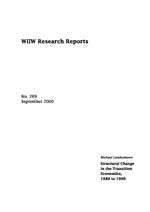Structural Change in the Transition Economies, 1989 to 1999
wiiw Research Report No. 269, September 2000
60 pages including 13 Tables and 21 Figures
This report gives an overview of patterns of structural change in Central and Eastern European economies over the decade 1989-1999. The analysis in this paper is restricted to a sub-sample of transition economies, namely the countries of Central and Eastern Europe (CEECs) - with the exception of the Baltic countries - which are currently also candidate countries for EU accession. While it would be interesting to extend the analysis to a wider range of transition economies, we were restricted by the use of a disaggregated database which allows reliable cross-country comparative analysis of patterns of structural change.* Furthermore, we only deal with a subset of issues which come under the heading of 'structural change': the focus of the analysis is on changes in the structures of production, employment and in the positions of CEECs in the European division of labour, i.e. on the CEECs' international specialization.
The structure of the paper is as follows: section 1 presents the broad patterns of sectoral change, i.e. the processes of deagrarization, deindustrialization and tertiarization which have taken place since the beginning of transition. Section 2 reviews some of the evidence on industrial restructuring and shows some interesting inter-country and inter-industry differences in this respect. Section 3 refers to the role which FDI plays in industrial restructuring and in the processes of industrial specialization of CEE economies. Section 4 reviews the developments of inter-industry and intra-industry specialization of CEECs in international trade with the EU. Section 5 refers to the evolving position of different CEECs in the European-wide division of labour and whether we can detect patterns of convergence in structure with different groups of EU economies. Section 6 reports the results of an econometric analysis of patterns of industry-level catching-up; the first part (6a) of this section deals with catching-up in productivity levels and wage rates, the second part (6b) with catching-up in product quality (measured by export unit values at a very detailed product level). Section 7 concludes with some remarks on the impact that EU accession might have on patterns of structural transformation and further East-West European integration.
Keywords: Central and Eastern Europe, structural change, transition economies, industry, trade, foreign direct investment
JEL classification: F02, F14, F21, L6, O4, O57, P52
Countries covered: Bulgaria, Czechia, Hungary, Poland, Romania, Slovakia, Slovenia, SEE, Visegrad countries
Research Areas: International Trade, Competitiveness and FDI, Sectoral studies
